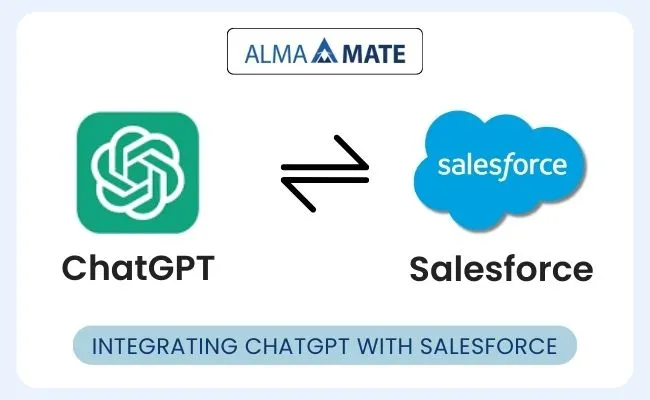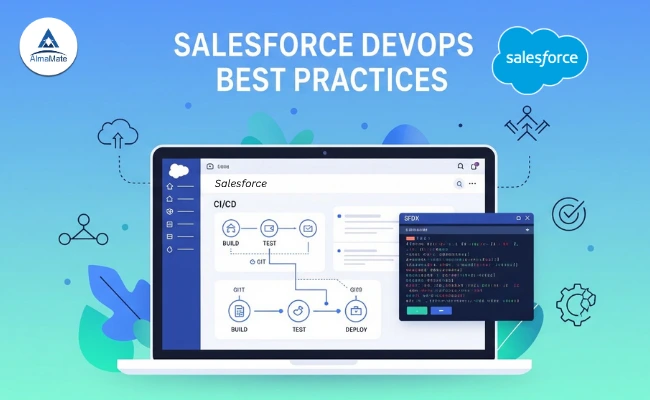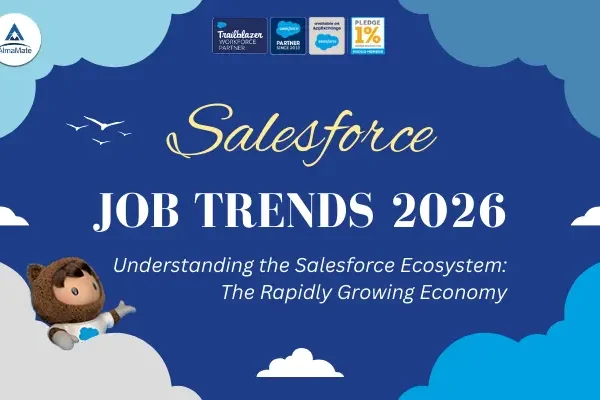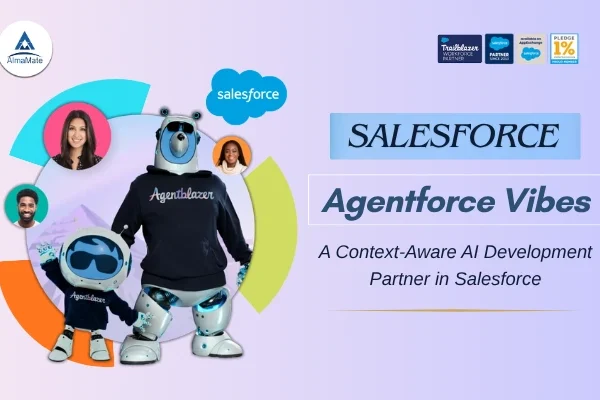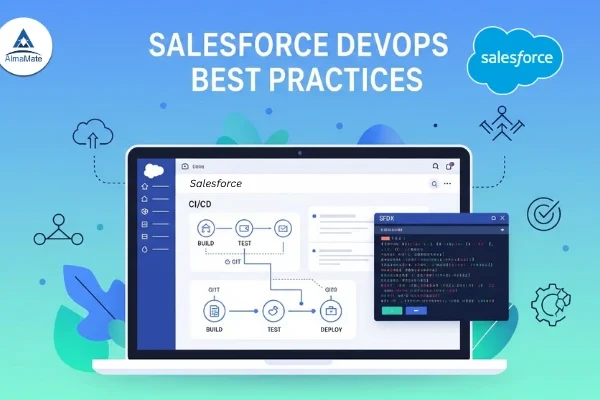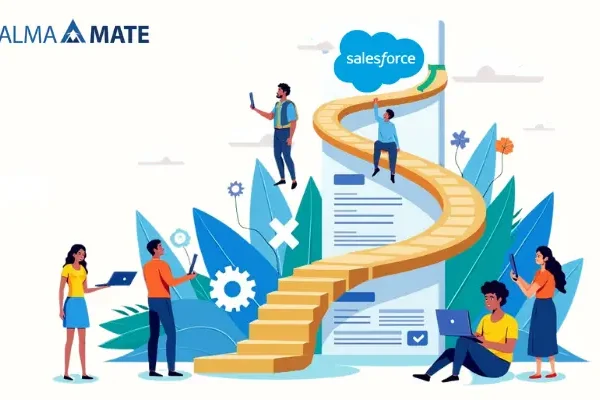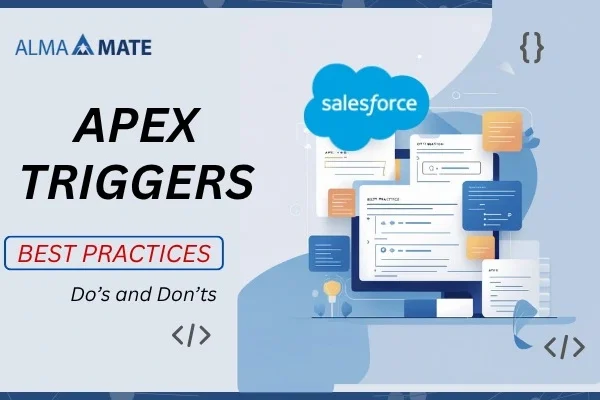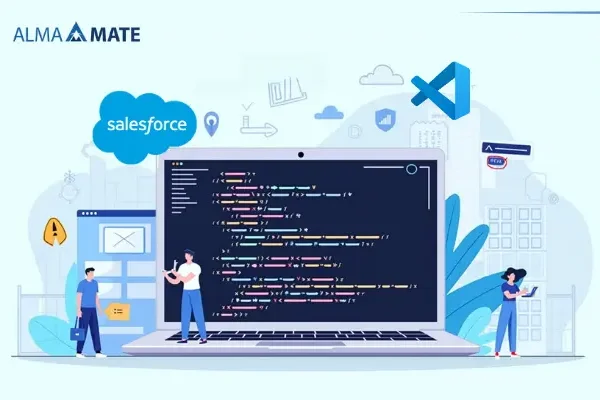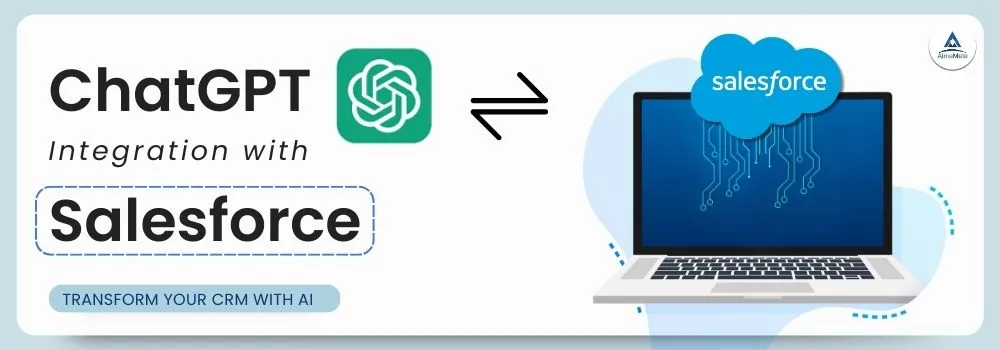
Table of Contents
Artificial Intelligence has moved far beyond being a futuristic concept and can now be used to integrate ChatGPT with Salesforce. It’s now in our inboxes, our phones, our CRM software, and even in the tools we use to make daily business decisions. Among all AI innovations, Generative AI — especially models like OpenAI’s GPT series — has caught the world’s attention. They’re no longer just playground demos; they’re actively reshaping how customer service teams, marketers, and salespeople get work done. ChatGPT integration with Salesforce is one such application.
If you already live in the Salesforce ecosystem, there’s good news: you don’t need to build something outside your CRM to take advantage of this technology. With a little bit of Apex code and a secure callout to the OpenAI API, you can embed GPT right into your Salesforce apps using ChatGPT integration with Salesforce. That means case replies drafted in seconds, knowledge articles summarized in one click, or even opportunity follow-up emails suggested on the fly.
This guide will walk you through the Salesforce and ChatGPT integration process:
- Why Salesforce + GPT is such a natural fit for ChatGPT integration with Salesforce
- Practical scenarios where Salesforce and ChatGPT integration make sense
- How the ChatGPT integration with Salesforce works behind the scenes
- A working Apex code sample to better understand this integration
- Some lessons learned on security, costs, and performance
Think of this less like a tutorial and more like a playbook you could hand over to your team tomorrow for them to understand how to integrate ChatGPT with Salesforce. Alright, let’s get real about testing this ChatGPT integration with Salesforce.
Why Pair Salesforce and GPT?
Salesforce is unbeatable at managing structured data — things like account records, contact details, opportunities, and case numbers. But the world isn’t made only of dropdowns and picklists. Customer conversations, emails, meeting notes, and support chats are all unstructured text, and that’s exactly what GPT is built to handle.
By bringing the two together, you get:
- Smarter case handling – GPT can skim case history and suggest empathetic replies that save agents time.
- Sales team productivity – reps can ask, “Summarize this opportunity and draft a follow-up email,” and get a ready-to-edit draft in seconds.
- Knowledge management – lengthy articles can be turned into crisp summaries or translated for multilingual customers.
- Custom business logic – from sentiment analysis to dynamic lead scoring, GPT can interpret text while Apex updates fields in the background.
In short, Salesforce provides context, while GPT offers language intelligence. Together, after the ChatGPT integration with Salesforce, they cover gaps that neither could fully solve on its own.
How the Architecture of a Salesforce and ChatGPT integration Works
Let’s imagine a service agent clicks a button inside Salesforce that says “Suggest Reply.” What actually happens?
- The button triggers Apex code.
- Apex prepares an API call with the case description as input.
- That request is sent to OpenAI’s endpoint.
- GPT processes it and sends back a draft reply.
- Salesforce shows the draft in the UI for the agent to review.
It’s really just a call-and-response cycle, but when you wire it into Salesforce records, the improvement in efficiency feels magical.
Preparing the Groundwork for ChatGPT Integration with Salesforce
To get started, you’ll need three things:
- An OpenAI account – and an API key from your dashboard.
- Salesforce Named Credentials – the safest way to store that key without hardcoding.
- Apex code – to send requests and handle responses.
In Salesforce Setup, head to Named Credentials, and create one pointing to:
https://api.openai.comAttach your API key there. This step keeps your org secure and ensures you’re not accidentally exposing secrets in your codebase.
Writing Apex That Talks to GPT
Here’s a simple Apex service class that calls the GPT model:
public with sharing class OpenAIService {
private static final String ENDPOINT = 'callout:OpenAI/api/v1/chat/completions';
public class ChatRequest {
public String model;
public List<Message> messages;
}
public class Message {
public String role;
public String content;
}
public class ChatResponse {
public List<Choice> choices;
}
public class Choice {
public Message message;
}
@AuraEnabled
public static String askGPT(String userPrompt) {
HttpRequest req = new HttpRequest();
req.setEndpoint(ENDPOINT);
req.setMethod('POST');
req.setHeader('Content-Type', 'application/json');
req.setHeader('Authorization', 'Bearer ' + System.Label.OpenAI_API_Key);
ChatRequest chatReq = new ChatRequest();
chatReq.model = 'gpt-4o-mini';
chatReq.messages = new List<Message>{
new Message{ role='system', content='You are a helpful Salesforce assistant.' },
new Message{ role='user', content=userPrompt }
};
req.setBody(JSON.serialize(chatReq));
HttpResponse res = new Http().send(req);
if (res.getStatusCode() == 200) {
ChatResponse chatRes = (ChatResponse) JSON.deserialize(res.getBody(), ChatResponse.class);
return chatRes.choices[0].message.content;
}
return 'Error: ' + res.getStatusCode() + ' - ' + res.getBody();
}
}This is enough to:
- Send a user prompt (like a case description)
- Receive GPT’s reply
- Display it wherever needed (Lightning Web Component, Flow, or even just a field update)
Putting It Into Action: Real Use Cases of Salesforce and ChatGPT Integration
Instead of thinking in abstract terms, let’s discuss situations where this makes a night-and-day difference.
1. Auto-Drafting Case Replies
Customer logs: “My order is delayed for the third time, and I’m frustrated.”
- GPT can instantly generate:
“We’re truly sorry about the repeated delays. I’ve escalated your case to our shipping team, and you’ll receive an update within 24 hours.”
The agent just reviews and sends, instead of typing from scratch. This is where a Salesforce and ChatGPT Integration proves useful.
2. Lead Enrichment
A lead note says: “Looking for cloud migration help, team size 2000, based in Mumbai.”
- GPT can interpret that as:
- Industry: IT Services
- Company Size: Enterprise
- Region: India
- Apex updates the corresponding Lead fields.
3. Summarizing Knowledge Articles
Nobody enjoys reading a 10-page knowledge article under pressure. With GPT, you can generate a 3-point summary like:
- Reset password using the self-service portal.
- If locked out, contact IT support.
- For urgent cases, call the helpdesk hotline.
4. Multilingual Support
Post content in English → GPT instantly creates Spanish, French, or Hindi versions. Store them as related translation records. This makes your Experience Cloud site reach out to audiences across the globe.
5. Drafting Sales Emails
Opportunity owner clicks “Generate Follow-Up Email.” GPT produces a draft:
“Hi Priya, it was great connecting yesterday. Based on your goals, I’ve attached a proposal outlining our cloud migration approach…”
It’s not perfect, but it’s 80% there — and that’s usually enough.
Adding a Lightning Web Component
Let’s say we want a small widget that shows a GPT-suggested reply inside a case.
HTML
<template>
<lightning-card title="AI Reply Generator">
<lightning-textarea label="Case Description" value={caseText}></lightning-textarea>
<lightning-button label="Generate Reply" onclick={handleGenerate}></lightning-button>
<template if:true={reply}>
<lightning-formatted-text value={reply}></lightning-formatted-text>
</template>
</lightning-card>
</template>
JS
import { LightningElement, track } from 'lwc';
import askGPT from '@salesforce/apex/OpenAIService.askGPT';
export default class CaseReply extends LightningElement {
@track caseText;
@track reply;
handleGenerate() {
askGPT({ userPrompt: this.caseText })
.then(result => { this.reply = result; })
.catch(err => { this.reply = 'Error: ' + err.body.message; });
}
}Now you have a working LWC that pulls GPT’s response directly into Salesforce.
Testing the Salesforce and ChatGPT Integration
Alright, let’s get real about testing this Salesforce and ChatGPT integration. Building the Salesforce and ChatGPT integration? Super cool. But proper testing is very important before pushing it into production. Seriously, you wouldn’t launch any Salesforce feature without poking and prodding at it first, so why let AI off the hook? Testing isn’t just, “Hey, do my Apex callouts return something?”. It’s about making sure this Salesforce and ChatGPT Integration won’t blow up, leak data, or spit out weird stuff when your users actually need it.
- Functional Testing
First up, does the whole thing(the Salesforce and ChatGPT Integration) actually work? Like, when your support agent clicks that “Generate Reply” button, does the message get to GPT and boomerang back, nice and clean? Stuff to check:
- Is the right info (like the case description) even making it to GPT?
- Does GPT answer in a format Salesforce can actually read, or is it just some unrecognizable value?
- Is your Lightning Web Component showing the AI’s answer without showing errors everywhere?
Pop open Developer Console, dig through the debug logs, and look at those JSON payloads. If you mess up the formatting even a little, get ready for multiple errors later on.
- Negative Testing
Honestly, real users do weird stuff. Empty fields, mile-long notes, emojis, Cyrillic, you name it. So, test the edge cases:
- What happens if someone leaves the prompt blank?
- What about a very long prompt?
- Emojis? Japanese? Some random characters?
- What if OpenAI just sends back garbage or fails altogether?
If the thing crashes, just show an error like this one: “Couldn’t generate a reply right now. Maybe try again or just write it yourself?”
- Performance Testing
This one’s big. GPT isn’t living inside Salesforce—it’s off in the cloud somewhere, so every interaction is an API call. That means lag can sneak in. Test for:
- How fast does it answer when you throw a tiny, one-liner prompt?
- How much slower for a monster 200-word prompt?
- What if five agents click on the “Generate” button simultaneously?
Salesforce gives you stuff like Apex tests and queueable jobs to fake heavy traffic, but don’t be afraid to bring in outside testing tools to really hammer those Named Credential callouts. You want the thing designed so that a short wait doesn’t make agents feel frustrated.
- Security Testing
Remember, you’re sending data out of Salesforce.
- Double-check you’re not sending PII unless you absolutely have to.
- Make sure Named Credentials aren’t exposing your keys to the world.
- Hit up your org’s audit logs—make sure you’re logging these callouts for compliance.
If you’re under GDPR, HIPAA, or other alphabet-soup regulations, drag InfoSec into this early. They’ll want to know exactly what data’s leaving, where it might be stored, and how you’re locking it all down.
- User Acceptance Testing (UAT)
Once you’re feeling good technically, hand it over to a few actual users. Sales reps, support agents, managers—whoever’s gonna live with this thing. Let them play around in a sandbox. Ask them the following questions:
- Are the AI replies actually any good?
- Is the UI obvious, or do they have to find the button they have to click?
- Does it save time, or is it just a shiny new way to waste minutes?
Their feedback is pure gold. Maybe you need to tweak the system prompts, or maybe some use cases are just not worth automating. Better to figure it out now.
Deployment & Scalability Considerations
Alright, so you’ve survived testing the Salesforce and ChatGPT Integration—awesome. Now comes the real test: how do you actually integrate ChatGPT with Salesforce so it doesn’t fall apart the second more than three people use it? Trust me, that “works on my machine” energy won’t cut it in a real Salesforce org, especially when the whole company’s poking at your shiny new AI features.
- Sandbox-to-Production Pipeline
Deploying straight to production is asking for pain. Stick with the classic Salesforce shuffle:
- Build and break stuff in a Scratch Org or Dev Sandbox. Hammer on your Apex callouts, Named Credentials, whatever Lightning Web Components you whipped up.
- Graduate to a Partial or Full Sandbox. Explore your UAT with scrubbed real data.
- You can then push it to production with Change Sets or a CI/CD setup using Salesforce DX, GitHub Actions, Copado, whatever floats your devops boat.
Why bother? Traceability. Rollbacks. Basically, something to fall back on when things inevitably come to a halt.
- Dealing with API Limits
Both OpenAI and Salesforce aren’t shy about slapping you with limits. Hit those rate caps, and suddenly, your “magic AI” stops working.
- Cache where you can—nobody needs to regenerate the same boring summary of the Terms & Conditions every five minutes.
- Batch your low-priority stuff. Queueable jobs are your friends.
- Got a ton of users? Use Platform Events or Async Apex.
Long story short: don’t let 200 support agents all hammer GPT at once.
- Watching Your Wallet (Cost Optimization)
OpenAI charges by the token, and those things add up faster than you think.
- Pick smaller, cheaper models for basic stuff. You don’t need the full brainpower of GPT-4 for summarizing an FAQ list.
- Standardize your prompts—store them in Custom Metadata. That way, you don’t get prompt bloat (and weird stuff sneaking in).
- Only turn on AI where it’s actually useful. Drafting cases? Sure. Mass email spam? Probably not worth it.
- Build some dashboards in Salesforce. Keep an eye on who’s using what.
- Error Handling
One must be ready for API errors as well:
- Retry logic with exponential backoff—don’t just keep hammering the API.
- Fallback templates, so users aren’t stuck staring at a blank screen if GPT is not working properly.
- Log everything. Use Event Monitoring or a real observability tool. Otherwise, you will be left guessing when things will go sideways.
- Governance and Compliance
- Lock down whoever can mess with system prompts, which fields go to GPT, and how responses are saved.
- Train your users. Don’t let some rookie auto-send a GPT draft to a customer without checking it first.
- Set real data retention policies. Who keeps what, for how long, and who can snoop on it?
The alternative? Chaotic AI mayhem and angry compliance folks.
- Planning for the Future (Because You Know They’ll Want More)
You think you’re done after case replies? Nah. Next up, multi-language, voice channels, WhatsApp bots—the works.
- Plan for global support. More languages imply more tokens, which in turn means more cash.
- Be ready for omni-channel interactions such as communication via chat messages, voice calls, etc.
- Keep your architecture modular. You don’t want to get stuck with only one LLM or vendor. Mix and match for optimum results (OpenAI for drafts, Anthropic for summaries, etc).
Best Practices Before You Roll Out a Campaign
- Keep data secure
- Don’t send PII (like phone numbers) unless you absolutely must.
- Log prompts and responses for compliance.
- Use Named Credentials for key management.
- Watch costs
- GPT-4 is powerful but pricey. For basic summarization, GPT-4o-mini or GPT-3.5 is more than sufficient.
- Cache results where possible.
- Handle scale
- Heavy usage? Queueable Apex or Platform Events can help.
- Put system prompts (the “instructions” you give to GPT) in Custom Metadata so admins can tune them without changing the code.
- Think adoption
- Always let users edit GPT outputs.
- Position it as a “drafting assistant,” not as an “authority” calling the shots or guiding you.
Looking Ahead
Today we’re talking about handling text-based conversations. Tomorrow, GPT inside Salesforce could also handle:
- Voice transcripts that are analyzed and logged automatically.
- Entire conversation histories being turned into opportunity summaries.
- AI “agents” that can not only suggest but also act, like creating tasks or sending follow-up emails without manual clicks.
Salesforce is already leaning in this direction with Einstein GPT, but rolling your own Apex + OpenAI integration(Salesforce and ChatGPT Integration) gives you flexibility and control.

Final Thoughts
Building a GPT-powered app in Salesforce isn’t science fiction anymore. With just:
- One Named Credential
- A small Apex class
- And a simple LWC
…you can put state-of-the-art AI directly into your org.
The goal isn’t to replace your team, but to free them from repetitive typing so they can focus on strategy and creativity.
If you’re a developer, try the code sample. If you’re an architect, think about how to wrap governance around it. If you’re a business leader, ask yourself: how much more could your team achieve if they had this at their fingertips?
The combination of Salesforce & GPT is not just a cool experiment — it’s the next productivity leap for CRM.
Embracing GPT-powered apps in Salesforce can completely redefine how your teams interact with customers, manage data, and make decisions. But successful ChatGPT integration with Salesforce requires the right expertise, strategy, and execution.
At AlmaMate Info Tech, we empower businesses to achieve exactly that. As a Salesforce Development Company, we go beyond standard implementations by providing custom Salesforce solutions aligned with your business goals. From AI-driven app development to automation and advanced CRM customization, we ensure that your Salesforce investment drives measurable impact.
At AlmaMate, we combine deep technical knowledge with industry best practices to ensure that your Salesforce investment drives measurable results. Our approach focuses on innovation, reliability, and long-term growth, so you can harness the true power of Salesforce and AI without complexity holding you back.

